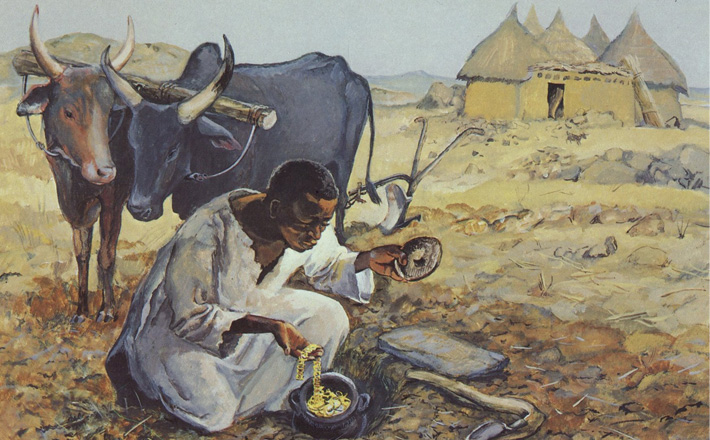Commentary on Matthew 13:31-33, 44-52
The parables assigned for the last two weeks comprise a narrative of moderate length followed some verses later by interpretations.
Not so the five short parables assigned for today. They are all very brief and have no section of explicit interpretation.
The absence of the latter feature requires us as readers to make sense of the comparison with “the empire of heaven” that introduces each parable (13:31, 33, 44, 45, 47). In addition to the scenario that each parable constructs, connections with what we have learned about God’s empire in the Gospel’s previous chapters provide a key step in making meaning.
So in the first of the parables, the empire of heaven is compared to a mustard seed that, when sown, grows into a tree in whose branches birds come to nest. The image of the mustard seed highlights initially its smallness and its invisibility when it is sown. Then the image expands to include its inevitable growth and flourishing, its resultant large size that contrasts with its small beginning, and its hospitable environment that sustains nesting birds.
How does this scenario help readers understand God’s activity that Jesus manifests as the empire of the heavens? First is the affirmation that that empire is present, though the sown small seed suggests its presence in small and invisible ways. The smallness anticipates the subsequent large tree, but it also reflects on the activity of Jesus.
Though the Gospel narrative presents him doing many works of preaching and healings that manifest God’s empire (4:23; 9:35), there is only so much one person can do. His activity is confined to Galilee (mostly) and for a limited period of time. Some people, notably the Rome-allied elites, do not seem to embrace his ministry and do not discern anything of God’s purposes in him, preferring to think of him as an agent of the devil (12:22-24). To some, God’s empire or saving presence is invisible.
The parable affirms that God’s empire is nevertheless at work and that it grows inevitably to become a bush and a tree, large enough for nesting birds. There is contrast between the small beginnings and a large culmination. Those who think God is absent from the world or ineffective or impotent, the parable engages with a contrary affirmation and vision of God’s present activity and endgame.
It encourages those discouraged by the apparent unchanging destructiveness of human interactions and structures. It offers a reframing for those perplexed by the overwhelming suffering of our lives and world to which God seems so often to be indifferent. It suggests to those who ask the age-old question of lament, “how long, O God, how long?” that the question is not rhetorical.
Stories of trees in the Hebrew Bible often concern power and rule. Jotham tells a story of trees anointing a king against his brother Abimelech who is staging a coup (Judges 9:7-15). Prophets use tree images to announce God’s power and rule over the imperial powers of Egypt, Assyria, and Babylon (Ezekiel 17:22-24; 31:1-18; Daniel 4:10-26). The mustard tree then depicts God’s empire that both resists and mimics all other empires to rule over all in a way that promises justice and life rather than oppression.
The nesting birds point to the same vision. The “birds of the heaven” symbolize the people of the nations who have lived under oppression (Ezekiel 17:23; 31:6; Daniel 4:12). In this mustard seed they find welcome and hospitality that supports life rather than destroys it. The parable is a prophetic word both reinscribing and resisting Roman imperial visions.
The second parable concerning yeast that a woman mixes with flour to leaven the whole batch demonstrates some similar emphases. Relative to the larger amount of flour, suggesting the final eschatological vision of abundant food (Isaiah 25:6-10a), the yeast is only a small quantity. Yet its small presence has big effects. The woman literally “hides” the leaven in the flour. That which seems to be invisible is in fact mysteriously and inevitably performing its leavening work. The status quo does not remain unchanged. By means of a time-consuming process, all of the flour “was leavened.” The passive voice indicates God’s transformative work in the world.
The third and fourth parables — the treasure hidden in a field and the very valuable pearl — continue some of these emphases (13:44-45). The element of the relative smallness of the present form of the kingdom continues. In 13:44 it consists of treasure in a much larger field. In 13:45 it consists of just one pearl.
Likewise, there is continued emphasis on the element of hiddenness. The treasure is hidden in the field while the pearl is not initially obvious. The repetition serves to underscore the importance of these perspectives.
But new emphases emerge, particularly the interplay of searching, finding, celebrating, and selling all in order to possess something of great value. The person who finds the treasure joyfully “sells all” to buy the field (13:44). The merchant “sold all” to buy the pearl. The discoveries disrupt normal daily life and priorities; they require risk and sacrifice. In these actions, the power of that which has been found is seen to be at work. The treasure and pearl possess the finders and shape their lives. So it is to participate in and be possessed by the empire of heaven; it is worth everything.
The final parable of Matthew’s chapter returns to an eschatological emphasis on the division of judgment evident in the weeds and the wheat (13:24-30). It turns from farming and trading to fishing to depict the future establishment of God’s reign and its victory over evil. The scope of God’s empire is universal (“fish of every kind”). Judgment at the end of the age separates the evil and the righteous who coexist up to this point, including in the church. The scenario reminds readers how important it is to “do the will of my Father in heaven” (12:50).


July 27, 2014